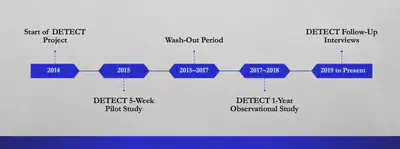Timeline

Detect
Who uses the elder mistreatment (EM) screening tool?
The screening tool is used by the emergency medical technicians and paramedics at MedStar Mobile Healthcare (MedStar), the largest EMS provider in North Texas, and Texas Adult Protective Services (APS).
Why do paramedics and medics use this tool?
Medics can see the environment of the older person when they respond to emergency calls. They quickly and thoroughly surveil the elderly and the environment without the need for direct questioning of the older adult or their caregiver, putting them in an ideal position to identify suspected cases of EM. Therefore, DETECT has the potential to provide medics with a valid, reliable, objective, fast, and easy to use screening tool based on systematic observation of the older adult and his/her home environment.
Where is the DETECT screening tool being used?
The DETECT screening tool is being used in Tarrant County, Texas.
Who are the participants in the DETECT project?
The DETECT project consists of community-dwelling adults, 65 years of age and older, residing in Tarrant County, Texas, who use emergency medical services.
What are the participants being screened for?
The participants are screened for indicators of potential mistreatment in their physical and/or social environments.
What are recruitment phone calls?
A recruitment phone call is a health and safety interview for adults aged 65 and older who recently used emergency medical services.
What are follow up interviews?
A follow-up interview is done a month after the DETECT screening with a simple random sample of older adults who speak English.
MedStar:
Contacts participants,
Schedule follow-up interviews,
Conducts capacity assessments,
Explains the informed consent process, and
Conducts follow-up interviews after obtaining written consent
A specially trained community paramedic visits each older adult’s home to collect data about the older adult’s medical history, current mistreatment status, the older adult’s physical and social environment, and other potential risk and protective factors. They take pictures of the inside and the outside of the older adult’s home, to be used later in the evaluation of the overall state of the older adult’s physical environment, identification of potential safety hazards, and formal evaluation for clutter and hoarding status.
Do participants get compensation for participation?
Participants who complete a one hour in-person interview with a MedStar community paramedic are given a $40 gift card.
What is the LEAD panel case review?
The paramedic presents the data collected from a random sample of the interviews completed throughout the previous month to a team of experts or the LEAD panel. The LEAD panel decides on EM after considering all the evidence presented. These LEAD panel determinations are used as a surrogate for an objective gold standard measure of EM.
What are the results of the DETECT Project?
Integrating the DETECT screening tool into the routine practices of medics is linked with a significant increase in clinician reporting of potential EM cases to APS.
Do we have any key outcomes?
We are still in the process of collecting data.



The estimated relative change in each group is presented in Table 1. Medics within the Medstar service area reported over four times as many cases of EA during the implementation of DETECT (RR=4.14, 95% CI:[3.25 5.27]). However, we also observed small pre-post changes among non-medics inside the MedStar service area and medics outside the MedStar service area, which indicates potential confounding in this crude estimate. After adjusting for changes in the number of EA reports in these comparison groups (i.e., underlying changes in reporting trends), our results indicate a roughly three-fold increase in reports (RR=3.03, 95% CI:[2.06, 4.46]) that may be attributed to the DETECT screening tool.
Further, the occurrence of EA was validated in 83% (95% CI:[75%, 91%]) of the reports investigated by APS in the periods when MedStar medics did not have access to the DETECT screening tool (study periods 1 and 3), compared to 82% (95% CI:[77%, 87%]) in the periods when MedStar medics did have access to the DETECT screening tool (study periods 2 and 4), indicating that there were no differences in the proportion of reports that resulted in a validated APS investigation. In other words, there was no evidence that the increases in reporting due to use of the DETECT tool were disproportionately invalid or inappropriate reports.
Featured Publications
Screening Tool
If you are interested in adopting the screening tool in your organization or research project, we are happy to collaborate. Please contact us by email.
Acknowledgements & Funding
This research was supported by the National Institute on Aging of the National Institutes of Health under Award Number R01AG059993. The content is solely the responsibility of the authors and does not necessarily represent the official views of the National Institutes of Health.
This project was supported by Award No. 2014-MU-CX-0102, awarded by the National Institute of Justice, Office of Justice Programs, U.S. Department of Justice. The opinions, findings, and conclusions or recommendations expressed in this publication/program/exhibition are those of the author(s) and do not necessarily reflect those of the Department of Justice.
We wish to acknowledge MedStar, Texas DFPS, and Adult Protective Services for their continuing support and dedication in this project. We also thank the National Institute of Justice for their ongoing support of this study.